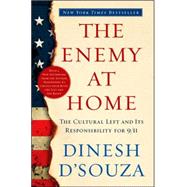
DINESH D’SOUZA, the Rishwain Research Scholar at the Hoover Institution at Stanford University, is the author of several bestselling books, including Illiberal Education, The Virtue of Prosperity, and What's So Great About America. He lives in Washington, D.C, and San Diego, California.
| Acknowledgments | p. xi |
| Introduction | p. 1 |
| Illusions on the Right: What Conservatives "Know" About 9/11, and Why It's Wrong | p. 29 |
| Reluctant Warriors: 9/11 and the Liberal Paradox | p. 47 |
| America Through Muslim Eyes: Why Foreign Policy Is Not the Main Problem | p. 68 |
| "The Head of the Snake": The Islamic Critique of Western Moral Depravity | p. 96 |
| Innocence Lost: Liberalism and the Corruption of Popular Culture | p. 119 |
| A World Without Patriarchy: Divorce, Homosexuality, and Other Liberal Family Values | p. 147 |
| A Secular Crusade: Yes, There Is a War Against Islam | p. 174 |
| Emboldening the Enemy: How Liberal Foreign Policy Produced American Vulnerability | p. 204 |
| The War Against the War: Decoding bin Laden's Message to America | p. 227 |
| The Left's Hidden Agenda: Unmasking the Liberal-Islamic Alliance | p. 254 |
| Battle Plan for the Right: How to Defeat the Enemy at Home and Abroad | p. 274 |
| Afterword: The Enemy at Home and Its Critics | p. 293 |
| Notes | p. 317 |
| Index | p. 347 |
| Table of Contents provided by Ingram. All Rights Reserved. |
The New copy of this book will include any supplemental materials advertised. Please check the title of the book to determine if it should include any access cards, study guides, lab manuals, CDs, etc.
The Used, Rental and eBook copies of this book are not guaranteed to include any supplemental materials. Typically, only the book itself is included. This is true even if the title states it includes any access cards, study guides, lab manuals, CDs, etc.
Excerpted from The Enemy at Home: The Cultural Left and Its Responsibility For 9/11 by Dinesh D'Souza
All rights reserved by the original copyright owners. Excerpts are provided for display purposes only and may not be reproduced, reprinted or distributed without the written permission of the publisher.